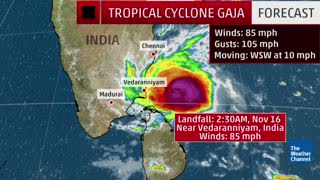Why in news?
Recently, Cyclone Gaja made its landfall between Nagapattinam and Vedaranyam in Tamil Nadu.
How prepared was the State?
- Tamil Nadu was more prepared than before to deal with Cyclone Gaja.
- More than 15 years ago, efforts were on to professionalise disaster management through a dedicated national and State organisation.
- It appears to be paying off, with bureaucracies acquiring higher efficiency in terms of early warning and impact mitigation.
- The National Cyclone Risk Mitigation Project was started by the Ministry of Home Affairs.
- This has been working to reduce the impact of such catastrophic events on Andhra Pradesh, Odisha, West Bengal, Tamil Nadu and Gujarat.
- Notably, these are classified as States with higher vulnerability; most western coastal States are in the next category.

What were the impact and the State response?
- Cyclone Gaja took a toll of at least 45 lives.
- The severe cyclonic storm damaged infrastructure, property and agriculture.
- It has affected some southern districts, felling tens of thousands of trees and also 30,000 electricity poles along the coast.
- It also hit residents in some central Kerala districts.
- State Disaster Management Authority issued a stream of alerts ahead of the cyclone.
- It helped coastal residents move to camps and adopt safety measures.
- State's measures after the cyclone, to clear roads, remove fallen trees and repair power infrastructure and communications, helped restore some stability.
- Tamil Nadu’s political parties have acted in a mature manner, keeping partisan criticism aside the relief and rehabilitation works.
- The government has to now secure without delay the financial relief.
- Rs. 10 lakh has been promised for families of the dead, besides the compensation for lost crops, trees and livestock.
- Also, provision of emergency health intervention and rehabilitation assistance to rebuild lives has to be ensured.
What is the way ahead?
- India’s coastline experiences a lower frequency of tropical cyclones compared to many other regions.
- But the loss of life and destruction is much higher.
- Coastal districts must thus continue to strengthen resilience against extreme weather events.
- They have to focus on reducing the hazard through policies to upgrade infrastructure and housing.
- States have to expand resilient housing, build better storm shelters and create financial mechanisms for insurance and compensation.
Source: The Hindu
